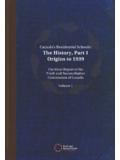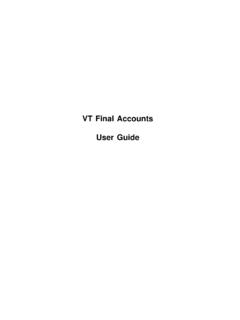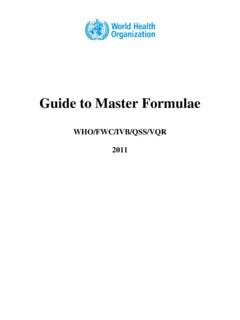Transcription of Canada’s Residential Schools: The Inuit and Northern ...
1 Canada's Residential Schools: The Inuit and Northern experience The Final Report of the Truth and Reconciliation Commission of Canada Volume 2. Canada's Residential Schools Volume 2. Canada's Residential Schools: The Inuit and Northern experience The Final Report of the Truth and Reconciliation Commission of Canada Volume 2. Published for the Truth and Reconciliation Commission by McGill-Queen's University Press Montreal & Kingston London Chicago This report is in the public domain. Anyone may, without charge or request for permission, reproduce all or part of this report. 2015. Truth and Reconciliation Commission of Canada Website: ISBN 978-0-7735-4653-0 (v. 2 : bound).
2 ISBN 978-0-7735-4654-7 (v. 2 : paperback). Printed in Canada on acid-free paper An index to this volume of the final report is available online. Please visit Library and Archives Canada Cataloguing in Publication Truth and Reconciliation Commission of Canada [Canada's Residential schools]. Canada's Residential schools : the final report of the Truth and Reconciliation Commission of Canada. (McGill Queen's Native and Northern series ; 80 86). Includes bibliographical references and index. Contents: v. 1. The history. Part 1, origins to 1939 The history. Part 2, 1939 to 2000 v. 2. The Inuit and Northern experience v. 3. The M tis experience v. 4. The missing children and unmarked burials report v.
3 5. The legacy v. 6. Reconciliation Issued in print and electronic formats. ISBN 978-0-7735-4649-3 (v. 1, pt. 1 : bound). ISBN 978-0-7735-4650-9 (v. 1, pt. 1 : paperback). ISBN 978-0-7735-4651-6 (v. 1, pt. 2 : bound). ISBN 978-0-7735-4652-3 (v. 1, pt. 2 : paperback). ISBN 978-0-7735-4653-0 (v. 2 : bound). ISBN 978-0-7735-4654-7 (v. 2 : paperback). ISBN 978-0-7735-4655-4 (v. 3 : bound). ISBN 978-0-7735-4656-1 (v. 3 : paperback). ISBN 978-0-7735-4657-8 (v. 4 : bound). ISBN 978-0-7735-4658-5 (v. 4 : paperback). ISBN 978-0-7735-4659-2 (v. 5 : bound). ISBN 978-0-7735-4660-8 (v. 5 : paperback). ISBN 978-0-7735-4661-5 (v. 6 : bound). ISBN 978-0-7735-4662-2 (v. 6 : paperback).
4 ISBN 978-0-7735-9817-1 (v. 1, pt. 1 : ePDF). ISBN 978-0-7735-9818-8 ( , pt. 1 : ePUB). ISBN 978-0-7735-9819-5 (v. 1, pt. 2 : ePDF). ISBN 978-0-7735-9820-1 (v. 1, pt. 2 : ePUB). ISBN 978-0-7735-9821-8 (v. 2 : ePDF). ISBN 978-0-7735-9822-5 (v. 2 : ePUB). ISBN 978-0-7735-9823-2 (v. 3 : ePDF). ISBN 978-0-7735-9824-9 (v. 3 : ePUB). ISBN 978-0-7735-9825-6 (v. 4 : ePDF). ISBN 978-0-7735-9826-3 (v. 4 : ePUB). ISBN 978-0-7735-9827-0 (v. 5 : ePDF). ISBN 978-0-7735-9828-7 (v. 5 : ePUB). ISBN 978-0-7735-9829-4 (v. 6 : ePDF). ISBN 978-0-7735-9830-0 (v. 6 : ePUB). 1. Native peoples Canada Residential schools. 2. Native peoples Education Canada. 3. Native peoples Canada Government relations.
5 4. Native peoples Canada Social conditions. 5. Native peoples Canada History. I. Title. II. Series: McGill Queen's Native and Northern series ; 80 86. 2016 '97 C2015-905971-2. C2015-905972-0. Contents 3. Section 1: Mission schools in the North: 1867 to 7. 1. An era of neglect: Canadian government policy in the North before 9. 2. Laying the groundwork: Mission schools: 1850 to 13. 3. Mission schools of the Northwest Territories: 1900 to 17. 4. Student Life at the Mission 37. 5. Education for what purpose?.. 45. 6. The mission era in the 57. Section 2: Bureaucrats replace missionaries: Residential schooling in the North after 71. 73. 7. The federal government rethinks its Northern 75.
6 8. The federal day 87. 9. The large 101. 10. The small 151. 11. Territorial administration: 1969 to 163. 12. The Residential school experience in Arctic Qu bec and 179. 187. 189. 249. Canada's Residential Schools Volume 2. Introduction R. esidential schooling in Canada's North deserves its own consideration for a number of reasons. First, its history is more recent than that of Residential schooling in the rest of the country. As late as 1900 there were only two Residential schools north of the sixtieth parallel. By 1950 there were only six Residential schools and one hostel in the North. This slow growth reflects the fact that while the overall goals of the Canadian govern- ment's Aboriginal policy were to assimilate, civilize, and Christianize, this policy was not applied in a uniform manner.
7 Where there was no pressing demand for Aboriginal lands, the federal government delayed taking on the obligations that Treaties created. This was particularly true in the North. As long as there was no prospect of economic development or of the arrival of large numbers of non-Aboriginal settlers, the federal government was not prepared to negotiate with Northern Aboriginal peoples. Nor was it interested in establishing reserves or Residential schools or any sort of school, for that matter. Were it not for the work of Roman Catholic and Anglican missionaries, Residential schooling would have no history north of the sixtieth parallel before 1950. A second distinct feature of the situation in the North was the fact that, in the years after 1950, the Canadian government did not simply extend the existing southern res- idential school system into Northern Canada.
8 Instead the federal government created a system of day schools and hostels under the direction of Northern Affairs rather than Indian Affairs. This system was intended from the start to be integrated into, not separate from, the public school system of the day. Unlike the southern schools, the Northern schools made no attempt to restrict admission to First Nations students, so M tis and Inuit , along with a number of non-Aboriginal students, also attended them. At the end of the 1960s, these schools were transferred from the federal government to the governments of the Northwest Territories and the Yukon. That jurisdictional transfer gave rise to a third difference between Residential schooling in the South and in the North.
9 From 1970 to the system's windup in the late 1990s, Residential schools were administered by Northern governments. Residences were located in both of the territorial capitals of the period, and Residential schooling 4 Truth & Reconciliation Commission was the subject of far more political attention and understanding than in the rest of the country. During the system's later years, former Residential school students were serving as premiers and ministers of Northern governments. Residential schooling in the North also played a major role in the rapid transfor- mation of the region's traditional, land-based lifestyles and economies. The tremen- dous distances that Inuit and some First Nations and M tis children had to travel to school meant that, in some cases, children were separated from their parents for years.
10 The establishment of day schools and what were termed small hostels in over a dozen communities in the eastern Arctic led many parents to decide to settle in those communities on a year-round basis so as not to be separated from their children. The large hostels in the western Arctic and Churchill, Manitoba, and later in Iqaluit (Frobisher Bay), brought a generation of Aboriginal youth from different regions and backgrounds into contact with one another. Many of these individuals would go on to play leading roles in the creation of the new territory of Nunavut in 1999. Finally, because Aboriginal people made up the majority of the population in two of the three Northern territories, the per capita impact of the schools in the North is higher than anywhere else in the country.





